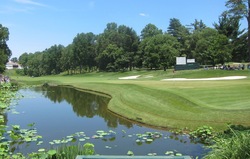The Congressional Low Scoring Panic
/I see Golf Digest readers are in a tizzy over the U.S. Open low scoring this year and I've seen some correspondences from the blue blazer world lamenting this year's setup and forgiving course conditions.
In this week's Golf World I explain what was going on with the course and why some of the conditions remained soft. But before you have the chance to read that story, let's consider a few things.
"Everybody knew those greens were going to be soft. My argument was, 'Why don't we have more rough? Why do we play the ladies' tees on half the holes?' Those were kind of things us angry old men were discussing," North said. "What has always set our championship apart from the other majors was the mental gymnastics you had to go through just to survive."
It's fascinating how the concept of varying tees with corresponding hole locations is blamed for the low scoring and the sense that the setup was not up to USGA standards. I'd put the fact that Congressional didn't play to its max yardage everyday a distant 9th on the list of reasons for the low scoring and simpler test. Here goes, in order:
 1. Congressional was in immaculate condition. Mike Giuffre and crew had the fairways absolutely perfect, the greens looked lousy early in the week but perked up after Thursday's rain, and you only saw putts hop in the evening hours. The greens could not have been more different than last year's bumpy poa at Pebble, nor could they have been more conducive to making putts.
1. Congressional was in immaculate condition. Mike Giuffre and crew had the fairways absolutely perfect, the greens looked lousy early in the week but perked up after Thursday's rain, and you only saw putts hop in the evening hours. The greens could not have been more different than last year's bumpy poa at Pebble, nor could they have been more conducive to making putts.
2. The greens were receptive to all shots, including from the rough. Why? A variety of reasons, most likely attributable to their newness and the USGA's decision to not lower cuts and strain them to pick up a few inches of Stimpmeter reading speed. Sub-Air can not impact the turf on top, just moisture that reaches the bottom of the USGA green. Moisture stayed at the surface for whatever reason and kept them soft.
3. The greens have very little contour and slope, require little local knowledge and make putting quite easy for today's players.
4. Players today hit the ball ridiculous distances with equipment that allows them to swing freely. Just as the USGA and PGA of America stated in their Tee It Forward campaign (but noticeably absent from the NBC graphic during this year's telecast), a course at 7600-7900 yards is the distance you would put more mid and long irons into their hands. Congressional, even from the tips, is too short to test today's players in a manner comparable to Open's from eras when equipment was in sync with architecture.
5. After Thursday, there was almost no wind whatsoever. No wind and today's players have one less thing to worry about.
6. The temperatures were warm and today's players drive it a mile in hot weather. Scoring is always good in hot weather.
 7. The Blue Course design features almost no strategy, does little to make player uncomfortable and only posed significant danger in three places: the 10th, 11th and 18th holes. With little to think about and fear, today's players are quite proficient at scoring.
7. The Blue Course design features almost no strategy, does little to make player uncomfortable and only posed significant danger in three places: the 10th, 11th and 18th holes. With little to think about and fear, today's players are quite proficient at scoring.
8. The bunkers had no bite. Mike Davis said that all spring, Congressional has struggled with the bunkers being too soft. With no rain 18 days prior to the event, steps were taken to firm them up enough. During the practice rounds they appeared just right, soft but balls were not plugging. But when the rains came, they firmed up and the lower cut around them went from sending balls to tough lies to more typical modern day manicured bunkers.
9. Congressional did not play to its maximum yardage. Had it been stretched to the max, I'm thinking the scoring average would have been impacted by at least .2 shots a day.
All of that said, the course produced a worthy champion who likely would have won had the conditions not gone so soft. I believe it would have been closer but ultimately, McIlroy was not going to be beat.











